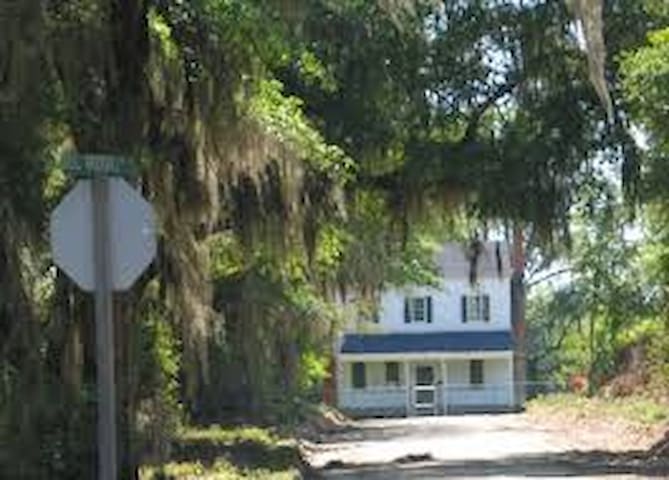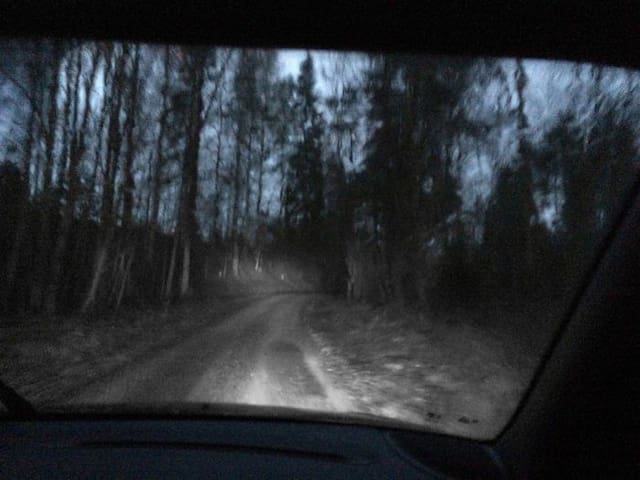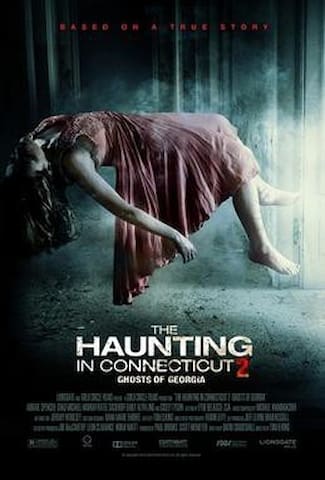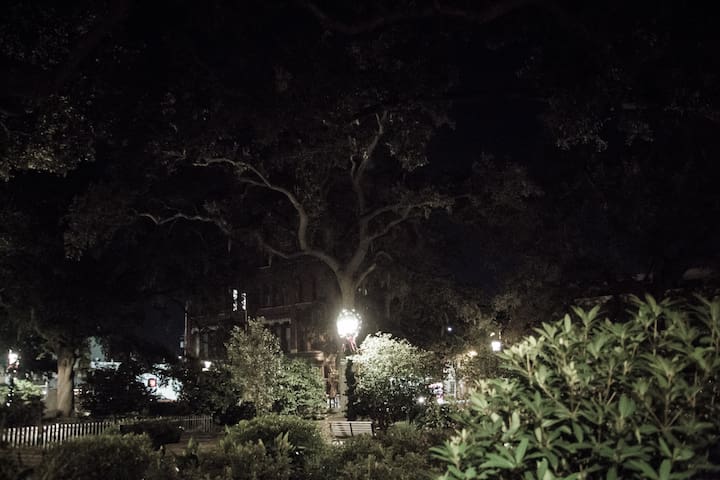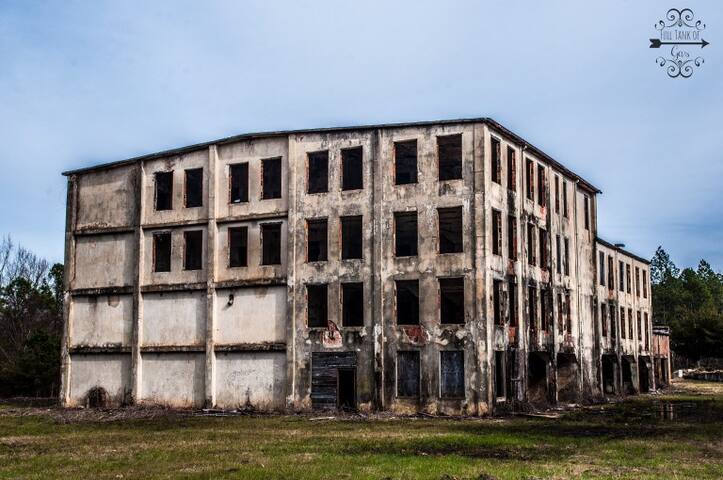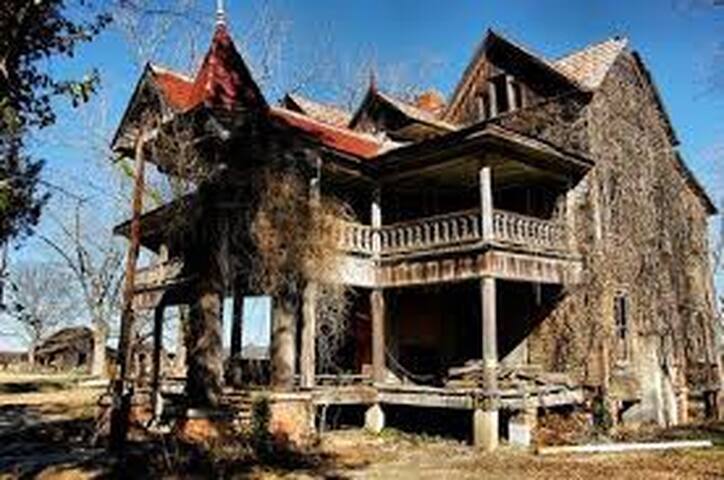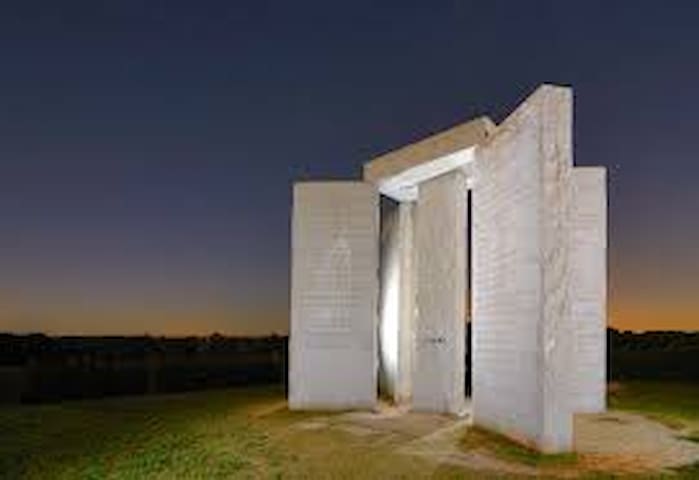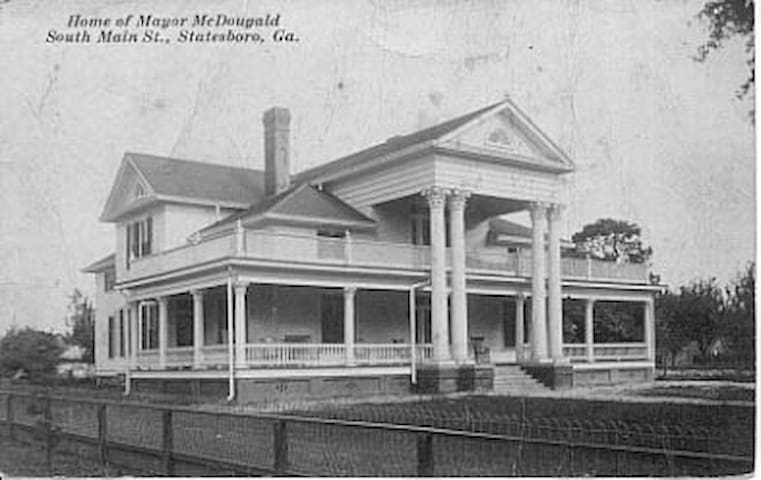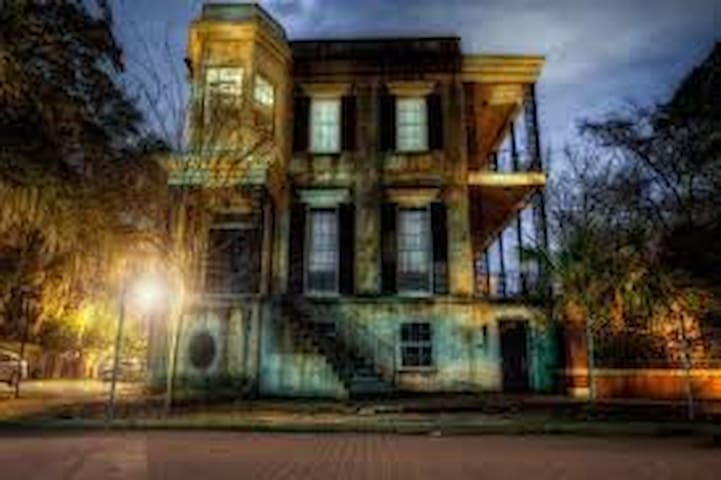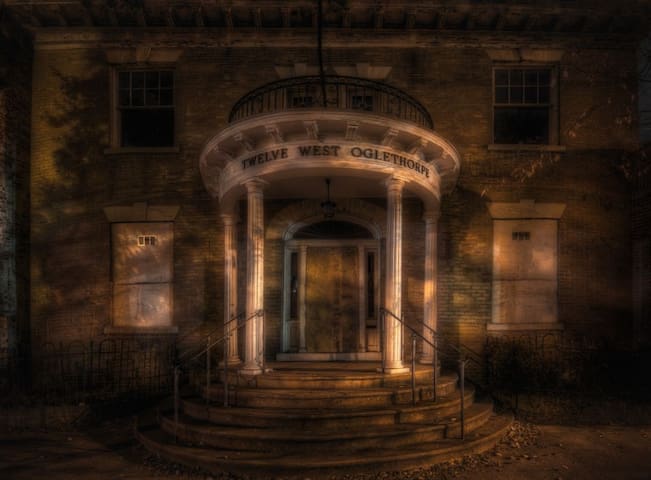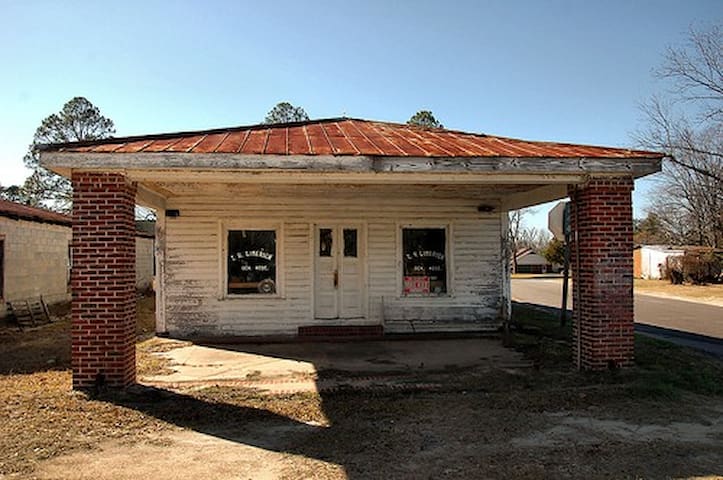Spooky
A single historic structure stands five miles north of Sylvania as the only evidence of the once booming town of Jacksonboro. And in its heyday, Jacksonboro was considered the most western frontier town of the United States. Named for the then governor of Georgia, Gen. James Jackson, the town held the county seat until a spring day in 1821 when the "curse" of a traveling preacher named Lorenzo Dow would change the face of the town forever. To commemorate the legendary story of Lorenzo Dow and the historic structure called the Seaborn Goodall house, the Brier Creek chapter of the Daughters of the American Revolution held a birthday celebration for Dow Sunday. The event also helped raise money to restore the Goodall house. DAR chapter regent Dahlia Bearden said it was a celebration of history and storytelling. The story of a pioneer town, an upstanding citizen and a traveling preacher will be recounted on the front porch of the early 19th-century home. In its prime, Jacksonboro attracted adventurers and fugitives alike, becoming one of the wildest frontier towns of American history. Some historians say there were as many saloons as there were all other businesses combined and little to no civil authority in place. Traveling mostly on foot, Connecticut-born Lorenzo Dow spent 40 years answering a God-ordained calling to spread the gospel of Christ throughout the country and others, including England and Ireland. Spending most of this time along the Atlantic seaboard, Dow made at least four tours of Georgia, one of which included his short but historical visit to Jacksonboro. As was his custom, the itinerant Methodist preacher passed out hand bills when he arrived announcing his call for a church meeting that night. In the hands of the town rowdies, the announcement was the beginning of a plot to break up Dow's meeting. At the ringing of the church bell, citizens gathered to hear his message, not more than a few hundred yards from the saloons, where the town rebels also heeded the cue. Before the close of the song service, the crowd that had gathered outside began throwing pieces of brick and stone into the open windows of the church, shooting off pistols in the air, and exciting a ruckus until Dow was forced to close the meeting. After his congregation returned safely to their homes, however, Dow demanded confrontation with his foes. Charging into the saloon, he used an iron tool to overturn a barrel of whiskey, allowing its contents to spill onto the floor before anyone could stop him. But he was soon pinned to the floor, and he may have received a vicious beating had not Seaborn Goodall stepped in. One of the few men who stood for law and order in Jacksonboro, Dow was Goodall's guest in his home during his stay. Goodall took him back to his home, where he nursed his bruises and showed him the only Christian love Dow saw during his visit. Goodall advised Dow not to try preaching in Jacksonboro again. On his way out of town the next day, however, Dow was seized again as he passed a saloon. This time, he was placed between two wide boards, with men sitting on the top board as Dow was sandwiched between. When they let him go, Dow retreated to the bridge over Beaver Dam Creek. There, it is said, he looked back and with a dramatic valediction, he dusted his feet of the town and pronounced an anathema, asking God to destroy the town as he did Sodom and Gomorrah, sparing only the home of Seaborn Goodall. Within a few years, floods, windstorms, and other natural disasters destroyed every building except one. After almost 200 years, the Goodall home still stands as a testament to Dow's short visit in Jacksonboro that spring day. Built in 1815 by Goodall himself, the house was home also to the Dell family in later years, and finally came into the hands of the Daughters of the American Revolution in the 1970s. The Brier Creek DAR chapter began a restoration project at that time, during which the house was cleaned up and after researching for accuracy, the group had the walls painted to match all the original colors in the house. Many antiques were donated to fill the house with period furniture, and the project was on its way to completion when the house was burglarized and almost all the antiques taken. After some years of little activity, the DAR members have embraced the project once again, desiring to see the house and its history gain the attention it should. Bearden said a renewed plan for restoration is the inspiration for Sunday's birthday celebration and fundraiser. The house stands just off Highway 301, where its white-columned face can be seen at the end of an otherwise deserted dirt road. Local artist Janis Waters Boucher donated a painting of the house, which was displayed, and smaller prints of her artwork were available for purchase. All money raised will be used for future renovations and development, said Hilda Boykin, manager of Sylvania's Downtown Development Authority and Better Hometown program. Janette Tew, a DAR member in charge of the restoration committee, said the group had just enough money to start painting and local businesses are working with the DAR to get the job done, including Jeren Brown, owner of Brown's Construction, and Possum Eddy's. The downtown authority and DAR members have high expectations for one day fully furnishing the house with original replica furniture and eventually installing a burglary alarm system. Regular scheduled tours and reenactments are also hopes for the future of the Dell Goodall house, said Boykin. As an already popular stopping point for tourists, the final product is expected to create quite a draw for additional tourism. About once a week, passersby drop in at the Chamber inquiring about the house, said Heidi Jeffers, Screven Chamber executive director. "We just want this to be something the community can take pride in," Tew said. "Everyone is very excited about the work being done and the future of the Dell Goodall house," Jeffers said.
Sylvania
A single historic structure stands five miles north of Sylvania as the only evidence of the once booming town of Jacksonboro. And in its heyday, Jacksonboro was considered the most western frontier town of the United States. Named for the then governor of Georgia, Gen. James Jackson, the town held the county seat until a spring day in 1821 when the "curse" of a traveling preacher named Lorenzo Dow would change the face of the town forever. To commemorate the legendary story of Lorenzo Dow and the historic structure called the Seaborn Goodall house, the Brier Creek chapter of the Daughters of the American Revolution held a birthday celebration for Dow Sunday. The event also helped raise money to restore the Goodall house. DAR chapter regent Dahlia Bearden said it was a celebration of history and storytelling. The story of a pioneer town, an upstanding citizen and a traveling preacher will be recounted on the front porch of the early 19th-century home. In its prime, Jacksonboro attracted adventurers and fugitives alike, becoming one of the wildest frontier towns of American history. Some historians say there were as many saloons as there were all other businesses combined and little to no civil authority in place. Traveling mostly on foot, Connecticut-born Lorenzo Dow spent 40 years answering a God-ordained calling to spread the gospel of Christ throughout the country and others, including England and Ireland. Spending most of this time along the Atlantic seaboard, Dow made at least four tours of Georgia, one of which included his short but historical visit to Jacksonboro. As was his custom, the itinerant Methodist preacher passed out hand bills when he arrived announcing his call for a church meeting that night. In the hands of the town rowdies, the announcement was the beginning of a plot to break up Dow's meeting. At the ringing of the church bell, citizens gathered to hear his message, not more than a few hundred yards from the saloons, where the town rebels also heeded the cue. Before the close of the song service, the crowd that had gathered outside began throwing pieces of brick and stone into the open windows of the church, shooting off pistols in the air, and exciting a ruckus until Dow was forced to close the meeting. After his congregation returned safely to their homes, however, Dow demanded confrontation with his foes. Charging into the saloon, he used an iron tool to overturn a barrel of whiskey, allowing its contents to spill onto the floor before anyone could stop him. But he was soon pinned to the floor, and he may have received a vicious beating had not Seaborn Goodall stepped in. One of the few men who stood for law and order in Jacksonboro, Dow was Goodall's guest in his home during his stay. Goodall took him back to his home, where he nursed his bruises and showed him the only Christian love Dow saw during his visit. Goodall advised Dow not to try preaching in Jacksonboro again. On his way out of town the next day, however, Dow was seized again as he passed a saloon. This time, he was placed between two wide boards, with men sitting on the top board as Dow was sandwiched between. When they let him go, Dow retreated to the bridge over Beaver Dam Creek. There, it is said, he looked back and with a dramatic valediction, he dusted his feet of the town and pronounced an anathema, asking God to destroy the town as he did Sodom and Gomorrah, sparing only the home of Seaborn Goodall. Within a few years, floods, windstorms, and other natural disasters destroyed every building except one. After almost 200 years, the Goodall home still stands as a testament to Dow's short visit in Jacksonboro that spring day. Built in 1815 by Goodall himself, the house was home also to the Dell family in later years, and finally came into the hands of the Daughters of the American Revolution in the 1970s. The Brier Creek DAR chapter began a restoration project at that time, during which the house was cleaned up and after researching for accuracy, the group had the walls painted to match all the original colors in the house. Many antiques were donated to fill the house with period furniture, and the project was on its way to completion when the house was burglarized and almost all the antiques taken. After some years of little activity, the DAR members have embraced the project once again, desiring to see the house and its history gain the attention it should. Bearden said a renewed plan for restoration is the inspiration for Sunday's birthday celebration and fundraiser. The house stands just off Highway 301, where its white-columned face can be seen at the end of an otherwise deserted dirt road. Local artist Janis Waters Boucher donated a painting of the house, which was displayed, and smaller prints of her artwork were available for purchase. All money raised will be used for future renovations and development, said Hilda Boykin, manager of Sylvania's Downtown Development Authority and Better Hometown program. Janette Tew, a DAR member in charge of the restoration committee, said the group had just enough money to start painting and local businesses are working with the DAR to get the job done, including Jeren Brown, owner of Brown's Construction, and Possum Eddy's. The downtown authority and DAR members have high expectations for one day fully furnishing the house with original replica furniture and eventually installing a burglary alarm system. Regular scheduled tours and reenactments are also hopes for the future of the Dell Goodall house, said Boykin. As an already popular stopping point for tourists, the final product is expected to create quite a draw for additional tourism. About once a week, passersby drop in at the Chamber inquiring about the house, said Heidi Jeffers, Screven Chamber executive director. "We just want this to be something the community can take pride in," Tew said. "Everyone is very excited about the work being done and the future of the Dell Goodall house," Jeffers said.
The March to the Sea Heritage Trail® (aka Sherman's March) is one of the Georgia Civil War Heritage Trails®. Collectively they are "the official statewide Civil War Historic Driving Trails of Georgia," designated by Georgia's Governor and General Assembly in 2010.
Sherman's army, split into left and right wings, made "Georgia howl" along two 300-mile driving routes from Atlanta to Savannah. This trail features historic homes, churches, depots, battlefields, forts, museums and more.
The "Left Wing" route travels from Stone Mountain through Conyers, Covington, Social Circle, Madison, Eatonton, Milledgeville, Sandersville, Louisville, Waynesboro, Sylvania, Ebenezer Creek and Port Wentworth to Savannah. The "Right Wing" route travels from McDonough, Jackson, Hillsboro, Clinton, Griswoldville, Gordon, Irwinton, Bartow, Millen, Oliver, Guyton, Pooler and Richmond Hill to Fort McAllister.
Follow their foot-steps from Atlanta to the sea where Civil War history was made.
Sylvania
The March to the Sea Heritage Trail® (aka Sherman's March) is one of the Georgia Civil War Heritage Trails®. Collectively they are "the official statewide Civil War Historic Driving Trails of Georgia," designated by Georgia's Governor and General Assembly in 2010.
Sherman's army, split into left and right wings, made "Georgia howl" along two 300-mile driving routes from Atlanta to Savannah. This trail features historic homes, churches, depots, battlefields, forts, museums and more.
The "Left Wing" route travels from Stone Mountain through Conyers, Covington, Social Circle, Madison, Eatonton, Milledgeville, Sandersville, Louisville, Waynesboro, Sylvania, Ebenezer Creek and Port Wentworth to Savannah. The "Right Wing" route travels from McDonough, Jackson, Hillsboro, Clinton, Griswoldville, Gordon, Irwinton, Bartow, Millen, Oliver, Guyton, Pooler and Richmond Hill to Fort McAllister.
Follow their foot-steps from Atlanta to the sea where Civil War history was made.
Located in the Southeast corner of Georgia is a quiet area known as Ebenezer Swamp. But it is said that whenever the swamp becomes swollen from rainfall that cries from spirits dating back to the Civil War pierce the silence.
Sometime in November of 1864, Union General William T. Sherman was told of alleged atrocities taking place at Camp Lawton, a Confederate prisoner of war camp located near Millen, Georgia. There are conflicting accounts of the validity of these claims, but upon hearing them, Sherman vowed to free his comrades and ordered his troops to begin marching South towards the camp.
However, before Sherman arrived at Camp Lawton, the Confederate troops stationed there were made aware of his approach. As a result, when Sherman entered the camp a month later, he found it deserted. Incensed that he was too late, Sherman ordered the entire camp burned to the ground. He next ordered his troops to continue moving south in pursuit of the Confederates who had vacated the camp.
As Sherman’s troops continued south, they began to attract a large number of slaves. To many of these slaves, Sherman’s troops represented a chance for freedom. Soon, entire slave families began gathering up their meager possessions and following the Union troops. There are reports that by the time the soldiers reached Ebenezer Swamp there were over 2,000 slaves with them.
Upon reaching the area surrounding Ebenezer Swamp, Union troops found that the heavy rains caused the riverbanks to overflow, washing away the roads. It was also discovered that while they were retreating, Confederate soldiers had destroyed the bridge over Ebenezer Creek, which was the only way to cross the swamp. In addition, nearby Confederates had begun to sporadically fire upon the Union solders from their hiding places along the Savannah River.
Seeing the need to cross Ebenezer Swamp as soon as possible, Union General Jefferson C. Davis immediately ordered the construction of a crude bridge. Davis also began to worry that the large number of slaves would impede his troops’ progress. As so, Davis gave orders that the slaves were to stand aside and wait until the Union troops had all safely crossed first.
On a dark, rainy night, the bridge was finally completed and Davis gave the order to cross. As instructed, the slaves stood silently and waited for their turn. However, as the Union troops crossed, Confederates opened fire. In the darkness, it was unclear as to where the Confederates were stationed. Davis feared that the enemy would use the bridge as a means for attacking his troops from the rear. And so, as soon as the last of his men were safely across, Davis ordered the bridge destroyed.
Upon seeing the bridge collapse, fear raced through the crowd of slaves gathered at the water’s edge. They had all heard the horror stories from other slaves and were convinced that if the Confederate Army captured them, they would be killed. And so, one by one, thousands of men, women and children jumped into the raging water in a last-ditch attempt at freedom.
Davis ordered his troops to ignore the cries for help and to continue moving forward. And while there are accounts of a few Union soldiers felling large trees in an attempt to create a makeshift bridge, the sad fact is that most of the slaves were simply left to drown. It is said that so many perished in the water that for some time after, their bodies piled high enough to create a macabre dam before finally washing away.
Today, if you find yourself in the area surrounding Ebenezer Swamp during the rainy season, you will undoubtedly hear the stories. For many claim that on dark, rainy nights, you will still hear the ghostly cries of those who bravely struggled for freedom—-a freedom that many of us today still take for granted.
Ebenezer Creek
Located in the Southeast corner of Georgia is a quiet area known as Ebenezer Swamp. But it is said that whenever the swamp becomes swollen from rainfall that cries from spirits dating back to the Civil War pierce the silence.
Sometime in November of 1864, Union General William T. Sherman was told of alleged atrocities taking place at Camp Lawton, a Confederate prisoner of war camp located near Millen, Georgia. There are conflicting accounts of the validity of these claims, but upon hearing them, Sherman vowed to free his comrades and ordered his troops to begin marching South towards the camp.
However, before Sherman arrived at Camp Lawton, the Confederate troops stationed there were made aware of his approach. As a result, when Sherman entered the camp a month later, he found it deserted. Incensed that he was too late, Sherman ordered the entire camp burned to the ground. He next ordered his troops to continue moving south in pursuit of the Confederates who had vacated the camp.
As Sherman’s troops continued south, they began to attract a large number of slaves. To many of these slaves, Sherman’s troops represented a chance for freedom. Soon, entire slave families began gathering up their meager possessions and following the Union troops. There are reports that by the time the soldiers reached Ebenezer Swamp there were over 2,000 slaves with them.
Upon reaching the area surrounding Ebenezer Swamp, Union troops found that the heavy rains caused the riverbanks to overflow, washing away the roads. It was also discovered that while they were retreating, Confederate soldiers had destroyed the bridge over Ebenezer Creek, which was the only way to cross the swamp. In addition, nearby Confederates had begun to sporadically fire upon the Union solders from their hiding places along the Savannah River.
Seeing the need to cross Ebenezer Swamp as soon as possible, Union General Jefferson C. Davis immediately ordered the construction of a crude bridge. Davis also began to worry that the large number of slaves would impede his troops’ progress. As so, Davis gave orders that the slaves were to stand aside and wait until the Union troops had all safely crossed first.
On a dark, rainy night, the bridge was finally completed and Davis gave the order to cross. As instructed, the slaves stood silently and waited for their turn. However, as the Union troops crossed, Confederates opened fire. In the darkness, it was unclear as to where the Confederates were stationed. Davis feared that the enemy would use the bridge as a means for attacking his troops from the rear. And so, as soon as the last of his men were safely across, Davis ordered the bridge destroyed.
Upon seeing the bridge collapse, fear raced through the crowd of slaves gathered at the water’s edge. They had all heard the horror stories from other slaves and were convinced that if the Confederate Army captured them, they would be killed. And so, one by one, thousands of men, women and children jumped into the raging water in a last-ditch attempt at freedom.
Davis ordered his troops to ignore the cries for help and to continue moving forward. And while there are accounts of a few Union soldiers felling large trees in an attempt to create a makeshift bridge, the sad fact is that most of the slaves were simply left to drown. It is said that so many perished in the water that for some time after, their bodies piled high enough to create a macabre dam before finally washing away.
Today, if you find yourself in the area surrounding Ebenezer Swamp during the rainy season, you will undoubtedly hear the stories. For many claim that on dark, rainy nights, you will still hear the ghostly cries of those who bravely struggled for freedom—-a freedom that many of us today still take for granted.
Crystal started out as Bone Pond. It was a originally a farm with a dried up pond. The owner was hung on the property.
A few days later this pond was no longer dry. It filled up. Nobody knows how. It became a huge lake. The land was purchased and the new owner brought in lots of white sand and slides. It was a popular place in Irwin county. It closed in the 90's. It was rumored to avoid the tree in the middle. The spot where the previous owner was hung. The murder was never investigated as nobody in town wanted the publicity.
Crystal Lake
Crystal started out as Bone Pond. It was a originally a farm with a dried up pond. The owner was hung on the property.
A few days later this pond was no longer dry. It filled up. Nobody knows how. It became a huge lake. The land was purchased and the new owner brought in lots of white sand and slides. It was a popular place in Irwin county. It closed in the 90's. It was rumored to avoid the tree in the middle. The spot where the previous owner was hung. The murder was never investigated as nobody in town wanted the publicity.
"Generally known as one of the most haunted spots in the area, two old dirt roads in Brooklet, Georgia have had many ghost hunters scared out of their wits.
Folks traveling late at night along Railroad Bed Road and Old Ghost Road (Robertson Road) might see something eerie if they park their cars and wait for about ten to twenty minutes in the pitch dark.
If you're patient enough, you might be able to see something interesting. A faint orange light (one witness said it's actually red) flashing in the distance will eventually show up, and as you drive closer to it, you might soon see a man appear digging a ditch.
Depending on the story, the ditch digger is either working on a plantation crop, searching for his head or digging his grave. If you're still brave enough to keep watching him, he might walk toward your car. One witness reported that he will vanish before your car reaches him, then re-appear under the orange light as you pass through and drive away.
In case you're still not freaked out, there is supposed to be a small cemetery nearby, which adds to the creepy vibe. Other witnesses have also seen a few ghost dogs roaming about the area.
Still, non-believers think it's an urban legend designed to scare gullible thrill-seekers. Perhaps it is a figment of their imagination working overtime. Whether it's a real paranormal phenomenon or a complete hoax, these roads remain a popular site for those looking for unexplained mysteries.
Brooklet
"Generally known as one of the most haunted spots in the area, two old dirt roads in Brooklet, Georgia have had many ghost hunters scared out of their wits.
Folks traveling late at night along Railroad Bed Road and Old Ghost Road (Robertson Road) might see something eerie if they park their cars and wait for about ten to twenty minutes in the pitch dark.
If you're patient enough, you might be able to see something interesting. A faint orange light (one witness said it's actually red) flashing in the distance will eventually show up, and as you drive closer to it, you might soon see a man appear digging a ditch.
Depending on the story, the ditch digger is either working on a plantation crop, searching for his head or digging his grave. If you're still brave enough to keep watching him, he might walk toward your car. One witness reported that he will vanish before your car reaches him, then re-appear under the orange light as you pass through and drive away.
In case you're still not freaked out, there is supposed to be a small cemetery nearby, which adds to the creepy vibe. Other witnesses have also seen a few ghost dogs roaming about the area.
Still, non-believers think it's an urban legend designed to scare gullible thrill-seekers. Perhaps it is a figment of their imagination working overtime. Whether it's a real paranormal phenomenon or a complete hoax, these roads remain a popular site for those looking for unexplained mysteries.
Heidi Wyrick is a gifted psychic with the ability to see and communicate with the spirits of the dead. Since she was eight years old, she has been able to see ghosts. It began in February 1989 after her parents, Andrew and Lisa Wyrick, moved to Ellerslie when she started seeing the friendly elderly apparition of a man named Gordy who played with her on the property. Lisa thought this figment was an invisible friend, but eventually Heidi encountered another spirit named "Con" who appeared at the front door in a t-shirt with blood all over it. When she told her mother, she thought someone was trying to kidnap her. Andrew searched the entire neighborhood for someone who fit the description but came up empty handed. Eventually, Lisa happened to mention Con and Gordy to her sister who had just bought the house next door. As it turned out, a man named James S. Gordy was its former owner. It had once belonged to Catherine Ledford's family, and Lisa got in touch with her. She verified that James died in 1974.
He owned a real estate company in Columbus and for many years, he was a Sunday School superintendent at Ellison Methodist Church. Although she had no photographs of him, she corroborated Heidi's description of him having gray hair and wearing a suit, tie, and shiny black shoes. Heidi began looking through them and picked out Catherine's Uncle Lon "Con" Batchelor. He died in 1957 of cancer, but he had lost his hand in a cotton gin before he was twenty years old in Ellerslie just as she had seen him. For the next four years, she continued to encounter the benevolent spirits of James Gordy and Lon Batchelor, both of whom had long been dead.
In 1993, Lisa became pregnant, and an evil spirit came to visit. "Heidi had never been scared of anything," she recalled. "She had never been scared of Con. She had never been scared of Mr. Gordy, but when she saw the dark figure in our hallway, she was hysterical." She and Andrew discussed moving, but the likelihood of Heidi seeing spirits elsewhere came up.
Her baby sister, Jordan, was born on February 3, 1994. Two weeks later, Lisa noticed deep gashes going down Heidi's face. Andrew just assumed she had inadvertently scratched herself during the night, but two nights later, he too woke up with a searing pain from three claw marks going around his side. It was believed the scratches were being caused by the dark entity Heidi saw.
Background: Unrevealed
Investigations: Noted parapsychologist, Dr. William Roll, has investigated the Wyrick House at their request. He visited the house in September of 1994. One of the first things he accomplished was to have Heidi identify Mr. Gordy's picture from a photo line-up. She was able to correctly identify him. "Having spoken to Heidi and her parents, I'm even more convinced that we are dealing with genuine para-psychological experiences.", he reports. "Then the question comes up, why are these things happening to this little girl?"
Extra Notes: This case first aired on the October 21, 1994 episode. It was also featured in A Haunting and as the basis for a movie, A Haunting In Georgia.
Results: Unsolved. Heidi is now a young woman and no longer lives in the old family home. She reports that she has not seen Mr. Gordy for years. However, she continues to see the mysterious dark figure, as well as numerous other spirits. The sightings are so frequent that she now takes them in stride. No explanation has ever been made for Heidi's visions. Sadly, Andrew Wyrick, Heidi's father, passed away in 2012; he was only 45 years old.
Ellerslie
Heidi Wyrick is a gifted psychic with the ability to see and communicate with the spirits of the dead. Since she was eight years old, she has been able to see ghosts. It began in February 1989 after her parents, Andrew and Lisa Wyrick, moved to Ellerslie when she started seeing the friendly elderly apparition of a man named Gordy who played with her on the property. Lisa thought this figment was an invisible friend, but eventually Heidi encountered another spirit named "Con" who appeared at the front door in a t-shirt with blood all over it. When she told her mother, she thought someone was trying to kidnap her. Andrew searched the entire neighborhood for someone who fit the description but came up empty handed. Eventually, Lisa happened to mention Con and Gordy to her sister who had just bought the house next door. As it turned out, a man named James S. Gordy was its former owner. It had once belonged to Catherine Ledford's family, and Lisa got in touch with her. She verified that James died in 1974.
He owned a real estate company in Columbus and for many years, he was a Sunday School superintendent at Ellison Methodist Church. Although she had no photographs of him, she corroborated Heidi's description of him having gray hair and wearing a suit, tie, and shiny black shoes. Heidi began looking through them and picked out Catherine's Uncle Lon "Con" Batchelor. He died in 1957 of cancer, but he had lost his hand in a cotton gin before he was twenty years old in Ellerslie just as she had seen him. For the next four years, she continued to encounter the benevolent spirits of James Gordy and Lon Batchelor, both of whom had long been dead.
In 1993, Lisa became pregnant, and an evil spirit came to visit. "Heidi had never been scared of anything," she recalled. "She had never been scared of Con. She had never been scared of Mr. Gordy, but when she saw the dark figure in our hallway, she was hysterical." She and Andrew discussed moving, but the likelihood of Heidi seeing spirits elsewhere came up.
Her baby sister, Jordan, was born on February 3, 1994. Two weeks later, Lisa noticed deep gashes going down Heidi's face. Andrew just assumed she had inadvertently scratched herself during the night, but two nights later, he too woke up with a searing pain from three claw marks going around his side. It was believed the scratches were being caused by the dark entity Heidi saw.
Background: Unrevealed
Investigations: Noted parapsychologist, Dr. William Roll, has investigated the Wyrick House at their request. He visited the house in September of 1994. One of the first things he accomplished was to have Heidi identify Mr. Gordy's picture from a photo line-up. She was able to correctly identify him. "Having spoken to Heidi and her parents, I'm even more convinced that we are dealing with genuine para-psychological experiences.", he reports. "Then the question comes up, why are these things happening to this little girl?"
Extra Notes: This case first aired on the October 21, 1994 episode. It was also featured in A Haunting and as the basis for a movie, A Haunting In Georgia.
Results: Unsolved. Heidi is now a young woman and no longer lives in the old family home. She reports that she has not seen Mr. Gordy for years. However, she continues to see the mysterious dark figure, as well as numerous other spirits. The sightings are so frequent that she now takes them in stride. No explanation has ever been made for Heidi's visions. Sadly, Andrew Wyrick, Heidi's father, passed away in 2012; he was only 45 years old.
Wright's Square is known for hangings.
One story is of Alice Riley.
Alice came here on a boat from Ireland. She was a slave to a mean man. She fell in love with the butler. They killed the master as he deserved to be killed. She was hung though in wright's square. Her hanging was on hod until she gave birth. She is seen in town asking if anybody has seen her baby.
253 habitants recommandent
Savannah
Wright's Square is known for hangings.
One story is of Alice Riley.
Alice came here on a boat from Ireland. She was a slave to a mean man. She fell in love with the butler. They killed the master as he deserved to be killed. She was hung though in wright's square. Her hanging was on hod until she gave birth. She is seen in town asking if anybody has seen her baby.
The most notorious haunting in Statesboro, the former meatpacking plant was the sight of a gruesome mass murder during the Great Depression. The owner set fire to the building but not before putting chains on all the doors and blocking the exits, trapping 23 employees inside. The owner then shot himself in the head, committing suicide.
People have reported seeing shadows running towards exits and the image of a woman through a third floor window, stricken with fear. During a full moon, it is said you can hear the sounds of gunshots and screams.
11 habitants recommandent
Statesboro
The most notorious haunting in Statesboro, the former meatpacking plant was the sight of a gruesome mass murder during the Great Depression. The owner set fire to the building but not before putting chains on all the doors and blocking the exits, trapping 23 employees inside. The owner then shot himself in the head, committing suicide.
People have reported seeing shadows running towards exits and the image of a woman through a third floor window, stricken with fear. During a full moon, it is said you can hear the sounds of gunshots and screams.
Located on Harville Road, the property was purchased in 1862 by Samuel Winkler Harville, who was a delegate from Bulloch County sent to the 1861 Secession Convention in Milledgeville. He voted for Georgia to secede during the convention. His son built the house in 1894 as a small, one-story farmhouse. Additions were added over generations and by 1946, the Harville House was a self-sustaining farm. However, in the 70’s the house was abandoned.
The hauntings occurred when two women died in the house but their deaths went unnoticed and their possessions remained. It is said that the two women can be seen in their rocking chairs from the front porch.
There is an added bonus of the Harville Cemetery, which is located a quarter mile away from the property. While the cemetery is not haunted, it is known to be a rather spooky addition to haunted trip.
11 habitants recommandent
Statesboro
Located on Harville Road, the property was purchased in 1862 by Samuel Winkler Harville, who was a delegate from Bulloch County sent to the 1861 Secession Convention in Milledgeville. He voted for Georgia to secede during the convention. His son built the house in 1894 as a small, one-story farmhouse. Additions were added over generations and by 1946, the Harville House was a self-sustaining farm. However, in the 70’s the house was abandoned.
The hauntings occurred when two women died in the house but their deaths went unnoticed and their possessions remained. It is said that the two women can be seen in their rocking chairs from the front porch.
There is an added bonus of the Harville Cemetery, which is located a quarter mile away from the property. While the cemetery is not haunted, it is known to be a rather spooky addition to haunted trip.
"That place was possessed by something evil."
That was the opinion of Herschel Tillman when he recalled his many visits to the home of Allen Powel Surrency when he was a boy in the early 1870s. He was just one of the thousands of witnesses to the strange and sometimes violent paranormal activity that plagued the Surrency home, making it one of the most well-known and witnessed cases of this kind in American history.
Allen Powel Surrency, a sawmill operator, was the founder of the small town of Surrency in southeastern Georgia. When returning home from a trip to Hazelhurst in October 1872, he found his house beset with the haunting. In a letter he wrote to the Savannah Morning News he said:
A few minutes after my arrival I saw the glass tumblers begin to slide off the slab and the crockery to fall upon the floor and break. The books began to tumble from their shelves to the floor, while brickbats, billets of wood, smoothing irons, biscuits, potatoes, tin pans, water buckets, pitchers, etc., began to fall in different parts of my house. There have been many other strange occurrences about my house. These facts can be established by 75 or 100 witnesses.
On the face of it, it sounds as if Surrency's house might have suffered an earthquake. In fact, that theory has been offered to explain the phenomena at the house. But that explanation does not hold up to scrutiny: the strange activity lasted weeks, even years off and on; the Surrency house was the only one affected, and an earthquake could not explain all of the bizarre phenomena described below.
And although the Surrency phenomena are usually referred to as a haunting and were attributed by witnesses to ghosts, the case actually has the earmarks of poltergeist activity, which is a psychic phenomenon rather than one that is caused by a residual or intelligent haunting. In fact, there seem to have been no reports of an apparition at Surrency.
Most poltergeist cases center around an "agent," usually a female of the age of puberty. At the time, the Surrency family had eight children ranging in age from 3 to 21.
News of this "haunting" spread like wildfire, and soon Surrency was the center of a media frenzy. Reporters and curiosity seekers from all over the country (and even England and Canada) descended on the little town in hopes of seeing the activity first-hand. Few were disappointed.
Paranormal Activity
Like the famous Bell Witch case, the poltergeist activity at the Surrency house was extreme and diverse. Here are just some of the reported phenomena:
Unexplained screams were heard
Voices came from an empty bedroom
Plates, platters, and books flew from their shelves
Ink bottles leap off a table
Doors opened and closed by unseen hands
The hands of clocks spun fast and even moved backward; a chime clock struck 13
Hot bricks fell from nowhere and landed on the roof and in the yard
A pair of boots trod across the floor on their own
At mealtimes, objects on the dinner table would "dance" around
Logs rolled out of the fireplace
Several hogs and chickens appeared in the living room, seemingly from nowhere, frightening one reporter out of his wits
Bedcovers rolled up and down at night
In an effort to rid his house and family of the terrifying activity, Surrency sought the help of the clergy, scientists as well as spirit mediums and psychics, all to no avail. Even after the house burned down in 1925, the action followed the family to their new home on the other side of the county.
It wasn't until Allen Surrency's death in 1877, it is said, that the haunting finally stopped. Some, however, say it continues to this day around the town of Surrency. In fact, there is a famous ghost light there: a bright yellow ball of light that appears along the railroad tracks.
Surrency
"That place was possessed by something evil."
That was the opinion of Herschel Tillman when he recalled his many visits to the home of Allen Powel Surrency when he was a boy in the early 1870s. He was just one of the thousands of witnesses to the strange and sometimes violent paranormal activity that plagued the Surrency home, making it one of the most well-known and witnessed cases of this kind in American history.
Allen Powel Surrency, a sawmill operator, was the founder of the small town of Surrency in southeastern Georgia. When returning home from a trip to Hazelhurst in October 1872, he found his house beset with the haunting. In a letter he wrote to the Savannah Morning News he said:
A few minutes after my arrival I saw the glass tumblers begin to slide off the slab and the crockery to fall upon the floor and break. The books began to tumble from their shelves to the floor, while brickbats, billets of wood, smoothing irons, biscuits, potatoes, tin pans, water buckets, pitchers, etc., began to fall in different parts of my house. There have been many other strange occurrences about my house. These facts can be established by 75 or 100 witnesses.
On the face of it, it sounds as if Surrency's house might have suffered an earthquake. In fact, that theory has been offered to explain the phenomena at the house. But that explanation does not hold up to scrutiny: the strange activity lasted weeks, even years off and on; the Surrency house was the only one affected, and an earthquake could not explain all of the bizarre phenomena described below.
And although the Surrency phenomena are usually referred to as a haunting and were attributed by witnesses to ghosts, the case actually has the earmarks of poltergeist activity, which is a psychic phenomenon rather than one that is caused by a residual or intelligent haunting. In fact, there seem to have been no reports of an apparition at Surrency.
Most poltergeist cases center around an "agent," usually a female of the age of puberty. At the time, the Surrency family had eight children ranging in age from 3 to 21.
News of this "haunting" spread like wildfire, and soon Surrency was the center of a media frenzy. Reporters and curiosity seekers from all over the country (and even England and Canada) descended on the little town in hopes of seeing the activity first-hand. Few were disappointed.
Paranormal Activity
Like the famous Bell Witch case, the poltergeist activity at the Surrency house was extreme and diverse. Here are just some of the reported phenomena:
Unexplained screams were heard
Voices came from an empty bedroom
Plates, platters, and books flew from their shelves
Ink bottles leap off a table
Doors opened and closed by unseen hands
The hands of clocks spun fast and even moved backward; a chime clock struck 13
Hot bricks fell from nowhere and landed on the roof and in the yard
A pair of boots trod across the floor on their own
At mealtimes, objects on the dinner table would "dance" around
Logs rolled out of the fireplace
Several hogs and chickens appeared in the living room, seemingly from nowhere, frightening one reporter out of his wits
Bedcovers rolled up and down at night
In an effort to rid his house and family of the terrifying activity, Surrency sought the help of the clergy, scientists as well as spirit mediums and psychics, all to no avail. Even after the house burned down in 1925, the action followed the family to their new home on the other side of the county.
It wasn't until Allen Surrency's death in 1877, it is said, that the haunting finally stopped. Some, however, say it continues to this day around the town of Surrency. In fact, there is a famous ghost light there: a bright yellow ball of light that appears along the railroad tracks.
In 1980, a nineteen feet three inches tall, granite monument resembling Stonehenge was erected in Georgia. Situated atop a desolate hill, the Georgia Guidestones is made of six granite slabs. There are ten guidelines in eight modern languages inscribed on these slabs. No one knows the designer of this massive structure or its purpose, hence it is shrouded in mystery and surrounded with numerous unanswered questions. Because of this, lots of speculation and conspiracy theories have sprung up around it.
Elbert County
In 1980, a nineteen feet three inches tall, granite monument resembling Stonehenge was erected in Georgia. Situated atop a desolate hill, the Georgia Guidestones is made of six granite slabs. There are ten guidelines in eight modern languages inscribed on these slabs. No one knows the designer of this massive structure or its purpose, hence it is shrouded in mystery and surrounded with numerous unanswered questions. Because of this, lots of speculation and conspiracy theories have sprung up around it.
The house was built in 1911 by John Alexander McDougald, a former mayor of Statesboro, and inherited down the family line until it eventually became the The Beaver House Inn & Restaurant that we know today. There is said to be six different ghosts that haunt the property, mostly from the family, including Ruth McDougald, who is one of the great-grandmothers, as well as two uncles and an aunt. There are, however, two ghosts in particular who are the most notable. One is Roy Beaver, one of the grandfathers, who stood at 6’6” weighing 480 lbs. The other is a girl named Annie who died on the same property that Pizza Hut now sits on, when she fell out of the tree she was climbing . Her spirit is the most prevalent of the six.
The ghosts are not harmful and many patrons only see them as glimpses or shadows, a blink-and-you-miss-it moment that is waved off. However, it has been known for small pranks to be played, locked doors to come unlocked and silverware to go missing
11 habitants recommandent
Statesboro
The house was built in 1911 by John Alexander McDougald, a former mayor of Statesboro, and inherited down the family line until it eventually became the The Beaver House Inn & Restaurant that we know today. There is said to be six different ghosts that haunt the property, mostly from the family, including Ruth McDougald, who is one of the great-grandmothers, as well as two uncles and an aunt. There are, however, two ghosts in particular who are the most notable. One is Roy Beaver, one of the grandfathers, who stood at 6’6” weighing 480 lbs. The other is a girl named Annie who died on the same property that Pizza Hut now sits on, when she fell out of the tree she was climbing . Her spirit is the most prevalent of the six.
The ghosts are not harmful and many patrons only see them as glimpses or shadows, a blink-and-you-miss-it moment that is waved off. However, it has been known for small pranks to be played, locked doors to come unlocked and silverware to go missing
The house was built in 1911 by John Alexander McDougald, a former mayor of Statesboro, and inherited down the family line until it eventually became the The Beaver House Inn & Restaurant that we know today. There is said to be six different ghosts that haunt the property, mostly from the family, including Ruth McDougald, who is one of the great-grandmothers, as well as two uncles and an aunt. There are, however, two ghosts in particular who are the most notable. One is Roy Beaver, one of the grandfathers, who stood at 6’6” weighing 480 lbs. The other is a girl named Annie who died on the same property that Pizza Hut now sits on, when she fell out of the tree she was climbing . Her spirit is the most prevalent of the six.
The ghosts are not harmful and many patrons only see them as glimpses or shadows, a blink-and-you-miss-it moment that is waved off. However, it has been known for small pranks to be played, locked doors to come unlocked and silverware to go missing
253 habitants recommandent
Savannah
The house was built in 1911 by John Alexander McDougald, a former mayor of Statesboro, and inherited down the family line until it eventually became the The Beaver House Inn & Restaurant that we know today. There is said to be six different ghosts that haunt the property, mostly from the family, including Ruth McDougald, who is one of the great-grandmothers, as well as two uncles and an aunt. There are, however, two ghosts in particular who are the most notable. One is Roy Beaver, one of the grandfathers, who stood at 6’6” weighing 480 lbs. The other is a girl named Annie who died on the same property that Pizza Hut now sits on, when she fell out of the tree she was climbing . Her spirit is the most prevalent of the six.
The ghosts are not harmful and many patrons only see them as glimpses or shadows, a blink-and-you-miss-it moment that is waved off. However, it has been known for small pranks to be played, locked doors to come unlocked and silverware to go missing
A doctor lived here. Yellow fever killed his family. He felt bad. He thought he had cure. He killed himself in the house.
He felt he should suffer so he starved himself to death.
Despite the history a young family purchased the house and there healthy baby fell ill and died of jaundice.
The mother was grief stricken & hung herself in the house. The house has been empty every since. Renovations had begun for a restaurant but yet have stopped.
The neighbors reports sounds and apparitions from around the property. No paranormal teams have been allowed to investigate.
253 habitants recommandent
Savannah
A doctor lived here. Yellow fever killed his family. He felt bad. He thought he had cure. He killed himself in the house.
He felt he should suffer so he starved himself to death.
Despite the history a young family purchased the house and there healthy baby fell ill and died of jaundice.
The mother was grief stricken & hung herself in the house. The house has been empty every since. Renovations had begun for a restaurant but yet have stopped.
The neighbors reports sounds and apparitions from around the property. No paranormal teams have been allowed to investigate.
Spooky
Many years ago in Screven County Georgia there was a small country community known as Six Bridges. The community consisted of no more than the homes of those who lived there and a rugged, one room church where all could be found on Sunday morning singing hyms and enjoying fellowship. There were no stores in Six Bridges so shopping was done in the nearby town of Hilltonia.
The people of Six Bridges were friendly and well liked by their Hilltonia neighbors. Talk had begun lately, however, that no one had seen anyone from Six Bridges in town for some time. The decision was finally made to make the trip to Six Bridges and see that everything was alright.
Six Bridges was several miles down a twisted road through the woods. The path was overgrown which made the trip difficult for the men and horses alike. When the woods finally cleared into Six Bridges, everything seemed to be in order. The men knocked on the front door of the nearest house. No answer. The knocked on the door of the second house. Again, no answer. They knocked on the third, then the fourth and began to call out loudly with no answer at all.
It was still three days till Sunday but they finally decided to check the church in case there had been a town meeting. The unpainted boards of the steps and front porch creaked as they walked toward the front door of the church breaking the deafening silence of the seemingly empty little town. When the doors swung open, they couldn't believe what they saw.
There was the entire town, neatly seated in the pews and the preacher at the pulpit.....all dead. There were no wounds, no signs of conflict, just the decaying bodies sitting with hymn books open.
In my life many made the trip down that winding wooded road the the old community of Six Bridges. All that remained was the tilted shell of the church. I was among the few who actually left the vehicle and, at the coaxing of the others in the car, walked up the rotting steps and across the porch of the church. When I pushed open the door I saw a sight that remains burned into my mind even today. There were the people of Six Bridges dressed in their Sunday best and the preacher standing at the podium. He looked up and right into my eyes with a cold, mournful look. His face was full of sadness and his eyes as black as coal.
No one was ever able to explain the mystery surrounding the deaths at Six Bridges. They finally tore down the church to keep us kids from going down there and the path has grown completely over. If you're ever in Screven County, just ask anyone where Six Bridges was. Anyone can show you, and anyone will tell you...stay out of the woods.
Hiltonia
Many years ago in Screven County Georgia there was a small country community known as Six Bridges. The community consisted of no more than the homes of those who lived there and a rugged, one room church where all could be found on Sunday morning singing hyms and enjoying fellowship. There were no stores in Six Bridges so shopping was done in the nearby town of Hilltonia.
The people of Six Bridges were friendly and well liked by their Hilltonia neighbors. Talk had begun lately, however, that no one had seen anyone from Six Bridges in town for some time. The decision was finally made to make the trip to Six Bridges and see that everything was alright.
Six Bridges was several miles down a twisted road through the woods. The path was overgrown which made the trip difficult for the men and horses alike. When the woods finally cleared into Six Bridges, everything seemed to be in order. The men knocked on the front door of the nearest house. No answer. The knocked on the door of the second house. Again, no answer. They knocked on the third, then the fourth and began to call out loudly with no answer at all.
It was still three days till Sunday but they finally decided to check the church in case there had been a town meeting. The unpainted boards of the steps and front porch creaked as they walked toward the front door of the church breaking the deafening silence of the seemingly empty little town. When the doors swung open, they couldn't believe what they saw.
There was the entire town, neatly seated in the pews and the preacher at the pulpit.....all dead. There were no wounds, no signs of conflict, just the decaying bodies sitting with hymn books open.
In my life many made the trip down that winding wooded road the the old community of Six Bridges. All that remained was the tilted shell of the church. I was among the few who actually left the vehicle and, at the coaxing of the others in the car, walked up the rotting steps and across the porch of the church. When I pushed open the door I saw a sight that remains burned into my mind even today. There were the people of Six Bridges dressed in their Sunday best and the preacher standing at the podium. He looked up and right into my eyes with a cold, mournful look. His face was full of sadness and his eyes as black as coal.
No one was ever able to explain the mystery surrounding the deaths at Six Bridges. They finally tore down the church to keep us kids from going down there and the path has grown completely over. If you're ever in Screven County, just ask anyone where Six Bridges was. Anyone can show you, and anyone will tell you...stay out of the woods.

